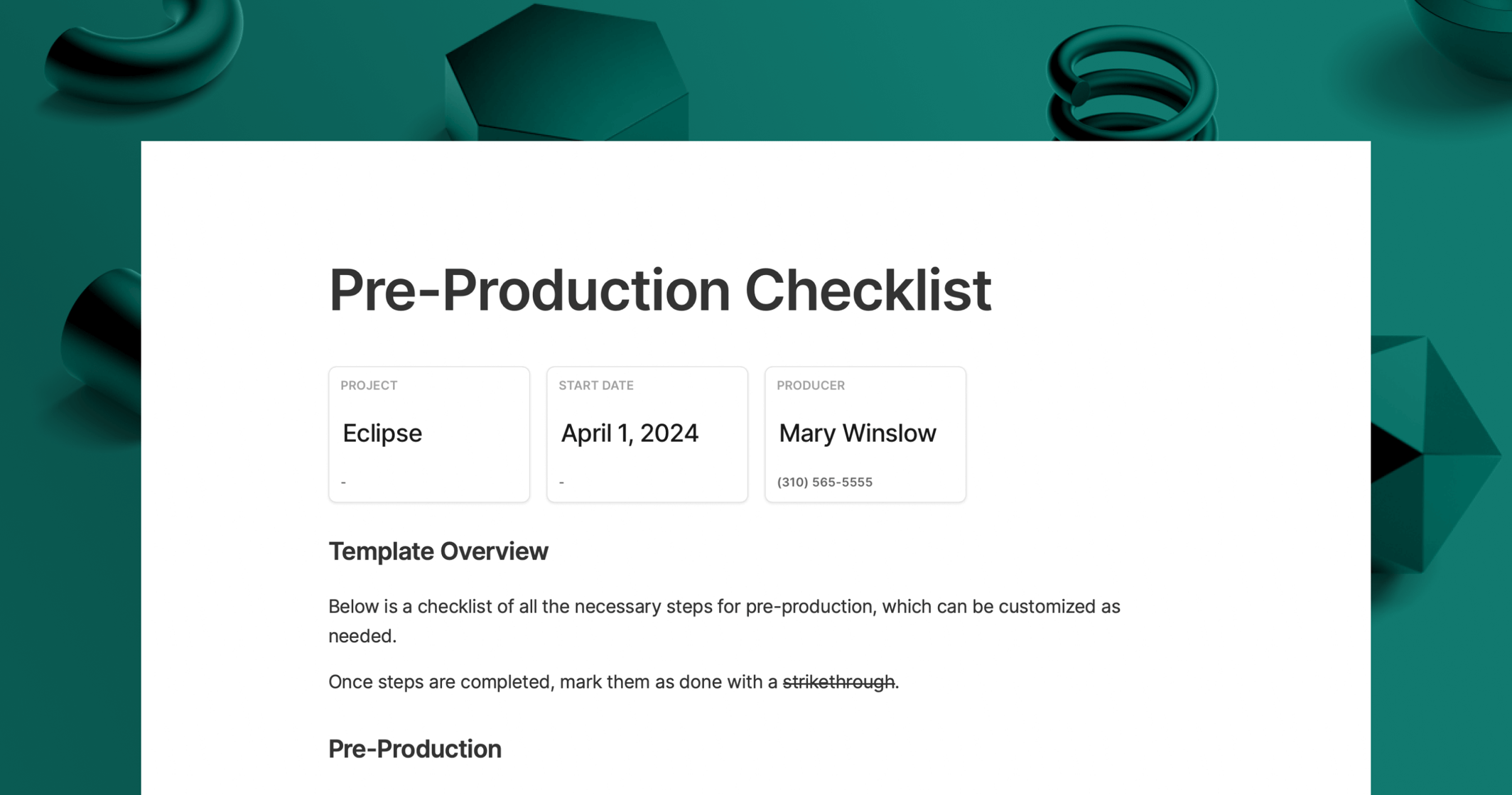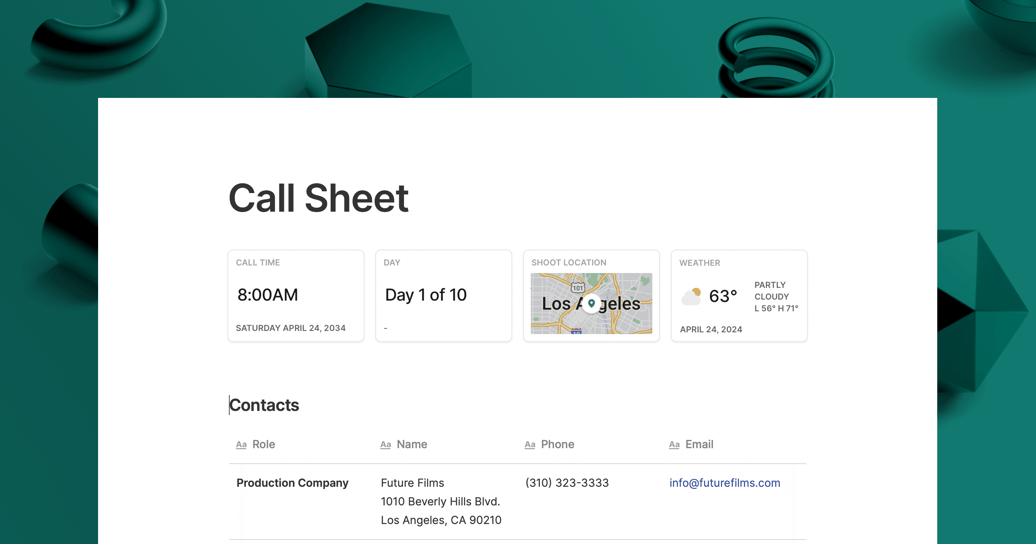To organize the many tasks that need to be accomplished before production begins, a pre-production checklist is essential. It's crucial for the director, producers, and crew to all agree on what must be accomplished in order for a film shoot to be successful. That’s why the importance of using a film pre-production checklist template cannot be overstated.
Click Use Template to get started with this template today.
When Should I Use the Film Pre-Production Checklist Template?
Pre-production refers to the planning and performing of all tasks required before production begins. And we all know the best laid plans often go astray. That’s why establishing a checklist at the outset of the filmmaking process is essential. It provides a roadmap to ensure producers and department heads are well-positioned to handle everything associated with production and post-production.
And don’t forget your production checklist and post-production checklist. The devil is in the details, and as important as it is to start organized, maintaining that order throughout the production process will be key to having a successful project. Check out all of our film templates for additional resources.
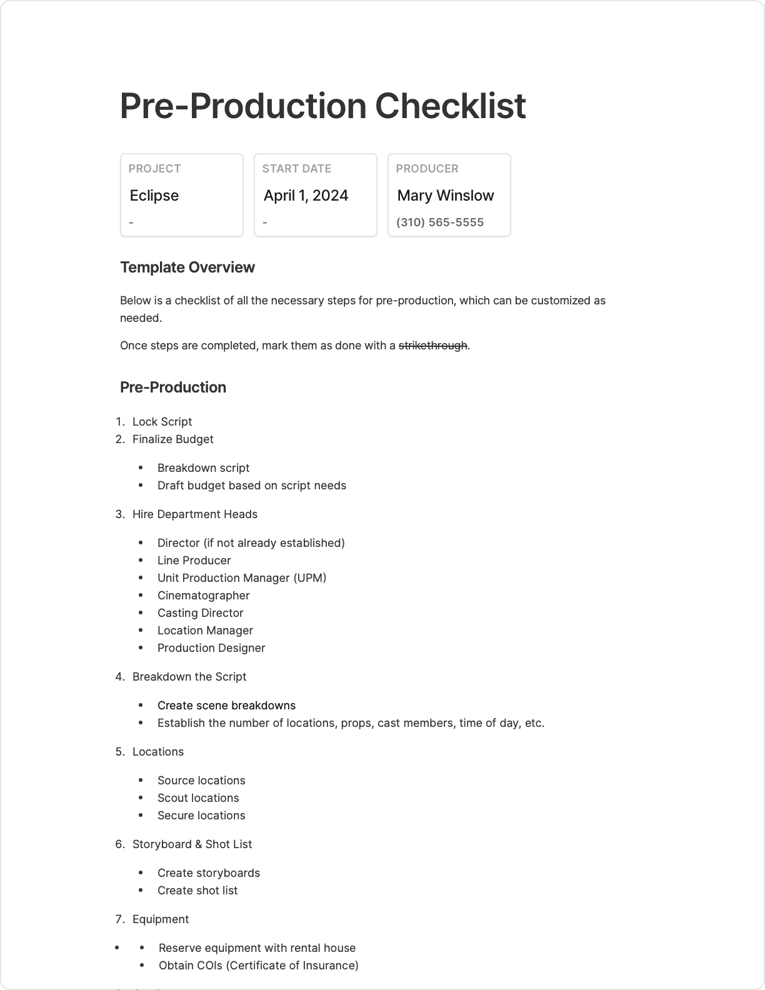
What Should I Look for in a Pre-Production Film Checklist?
There may be individual needs for your production crew for every project, which is why a fully customizable pre production film checklist is necessary. The most important thing to remember is that the goal is to have a production company document of checks and balances that provides clarity so nothing is overlooked during the process.
In general, there are 15 tasks that should be included in your pre-production checklist template. We’ll list the main steps here, and then break down all of the sub-steps within the template. Click Use Template for instant access to the full checklist.
- Lock the Script
- Finalize the Budget
- Hire Department Heads
- Breakdown the Script
- Scout and Secure Locations
- Create the Storyboard and Shot List
- Secure Equipment
- Audition and Cast Talent
- Schedule Rehearsals
- Finalize Art Needs
- Finalize Wardrobe
- Permits and Contracts
- Create Shooting Schedule
- Hire Remaining Crew
- Production Prep
Why is a Pre-Production Video Checklist Important?
Quick. Without scrolling up, repeat all 15 tasks we named above. Don't worry, you aren't in grade school anymore. There is no production schedule test to take. In fact, we encourage the cheat sheet. This pre production video checklist can be used as a starting point for anything from a feature film to a marketing video.
The benefits of using a checklist for your pre-production process:
- Organization results in fewer unforeseen issues during production.
- Communication problems can be reduced by knowing which departments and crew members are responsible for each task.
- A pre-production checklist ensures each step is accounted for on the budget.
How to Create a Film & Video Pre-Production Checklist
Using our video pre production checklist template you can start with a thorough outline of every step needed for pre-production. You'll be able to add additional details and notes, as well as view and edit all of the sub-tasks.
1. Open the Template
Open this template by clicking Use Template. The template will be created within a new blank project in Assemble.
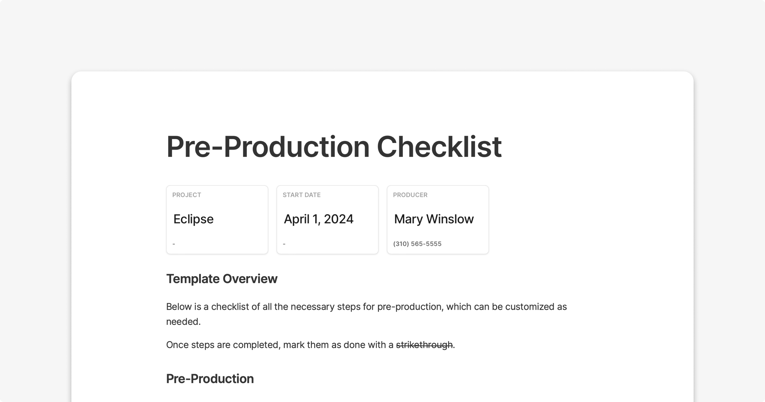
2. Edit the Template as Needed
Click anywhere within the text to begin adding to or editing the template.
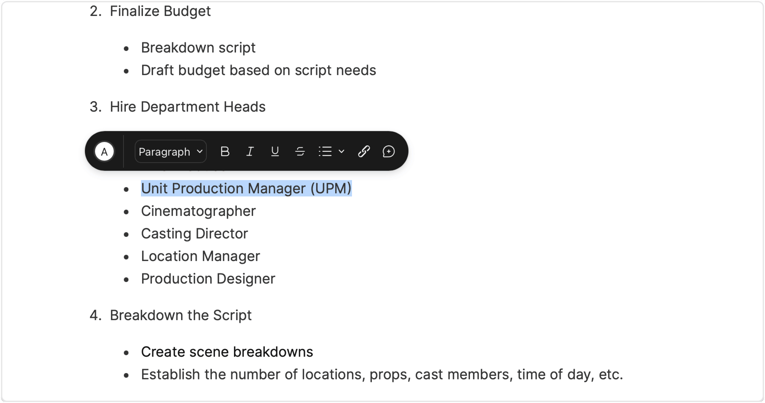
3. Share the Document
Click Share and select Share Document to easily distribute the document to your entire team with one click. You can even track who has viewed the document.
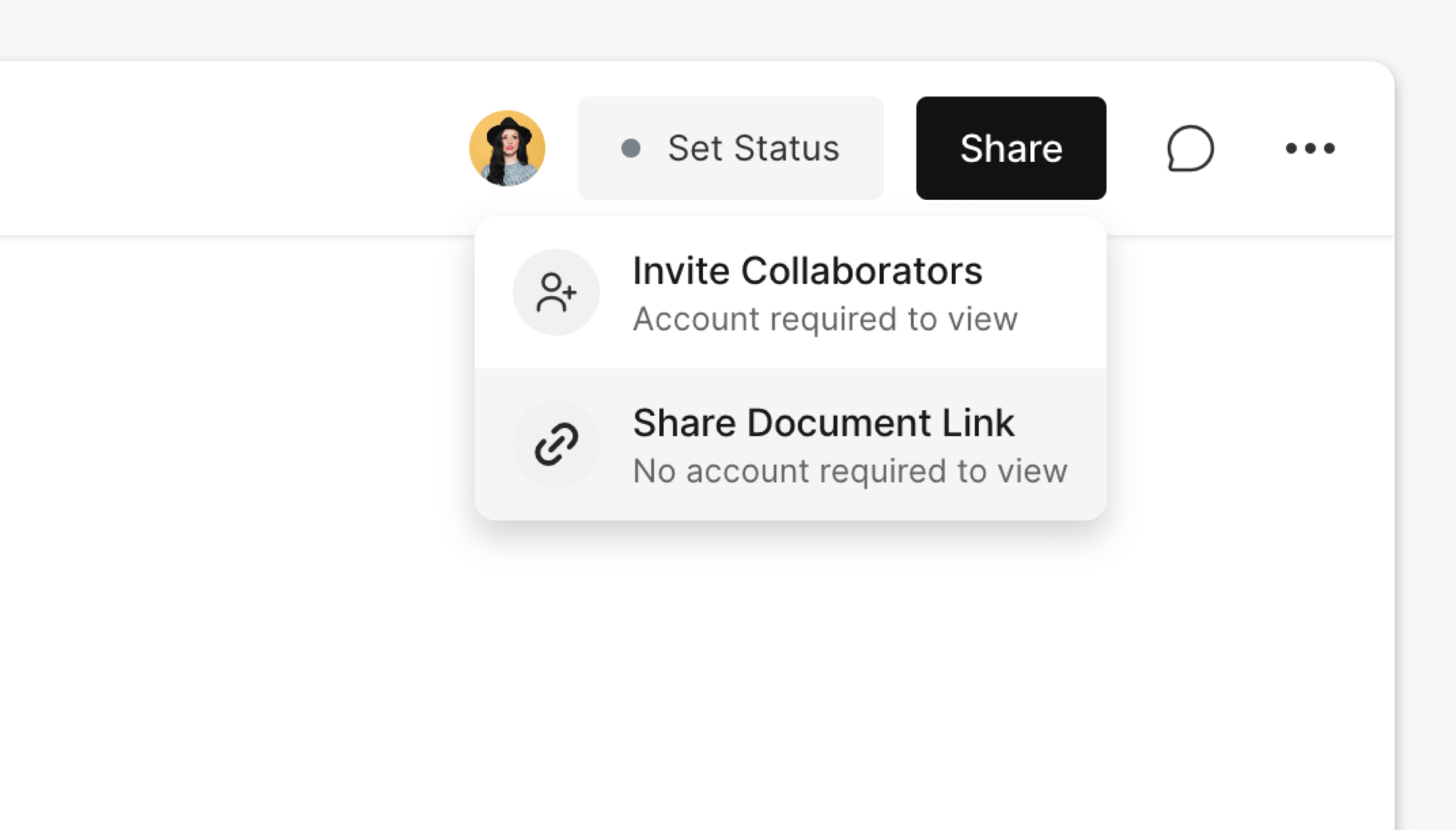
4. Save the Updated Template for Future Projects
Once you've updated it based on your needs, click the menu in the top right and select Save as Template to save it into your your personal template library.

Understanding the Steps of Pre-Production
Below, we'll give a high level overview of every major step of pre-production included in the template. Open the template to access the full list of tasks and subtasks.
1) Lock the Script
As screenwriter James V. Hart says “no one works until the screenwriter is done”. While technically you don’t have to start with a locked script, it’s an advisable first step as so many decisions such as cast, shooting schedule, filming locations and equipment are based on the needs of the script. Naturally, the creative team may tweak the script during production, but before you determine the budget, you'll want a solid sense of what you'll be filming.
2) Finalize the Budget
From past experience or earlier drafts of the script, you may have an idea how much the film production will cost to produce. Nonetheless, a real cost budget can be determined at this point after the screenplay has been locked and if the project has a director on board after creative needs have been discussed.
3) Hire Department Heads
Time to get this party started. There is a script, a budget and a place to draft agreements. Film is a collaborative process with so many moving parts. It’s at this stage that other producers would be brought in including most importantly the line producer and unit production manager or UPM. If a director is not already attached, this would be a key hire as that person would have opinions on bringing in a cinematographer and perhaps other department heads they’ve worked with on other productions.
4) Breakdown the Script
The script may be locked, but the key to moving forward is to understand how to achieve the sum of all parts. The script is combed over like a game of Operation where you carefully pick out every important detail. For example, how many locations are there? And how many props? How many roles and background? To help understand how to take it from the page to the screen, all these elements are then compiled into lists and reports. Remember that finalized budget? During the script breakdown, you might make some key discoveries that affect how, where, and how much money is allocated.
5) Scout and Secure Locations
The script is the what, the budget the how, but at this stage the where becomes priority number one and that means finding and securing locations. Sometimes it’s very straightforward. When supervising location manager Robert Foulkes worked on La La Land, the city itself was a prominent character and some locations were named in the script such as Griffith Observatory and The Lighthouse Café in Hermosa Beach.
But often, it’s collaborating with the director, producers and the production designer to find suitable locations that work both artistically and logistically. Is there enough parking for the cast and crew? Does this location fit into the plan for a company move where production can make its day within budget? Does the director have her heart set on an ocean view and this specific house doesn’t allow it? It’s a balancing act of wants vs. needs and it’s always smart to have a contingency plan in place should your primary location fall through.
6) Create the Storyboard & Shot List
This is where the words and actions on the page are turned into visual references. Think of comic books that tell a story through images. A series of panels drawn by hand or by software translate the director's vision into images to plan shots. A storyboard can either be rough sketches or more intricate, detailed drawings, depending on the creative team's needs and the budget. The objective of a storyboard is not necessarily to have beautiful images, but rather to convey the story's intent with clarity through visual storytelling which may be lost in text.
Next up, you need a shot list to ensure you are not flying blind as there is nothing more frustrating to the crew than starting the work day without a clear plan in place. You can’t light or block a scene without knowing the shot and you can’t fully understand if you’ll have everything you need in the edit without knowing the coverage. The director and the cinematographer should develop the shot list, with the assistant director keeping them honest throughout the day. This is important. Depending on time, hard choices may have to be made to consolidate or eliminate shots.
7) Secure Equipment
We’ve talked a lot about software when prepping schedules and shot lists, but it’s the hardware that gets the job done during production. You need lights. You need sound. You need cameras. You need storage. You may arrange all this much earlier in the process, but usually knowing exactly what you’ll need involves many of the prior steps to solidify equipment needs. Still, it’s a good idea for a preliminary equipment wish list to be floating around before the final list is set after locations are viewed and scouted for any ancillary issues.
8) Audition and Cast Talent
Gaining wide distribution is almost always linked to having talent attached, unless it is a genre piece such as horror. Here we are dealing with the step that may have overlapped an earlier one. For example, finalizing the budget might have been contingent on star talent. Although you can handle casting in-house, hiring a casting director with relationships with agents and managers is a good idea. A casting director can coordinate the process of making offers, negotiating contracts and auditioning for secondary roles. For background actors, stand ins, and doubles, you need a casting company that specializes in non-speaking roles.
9) Schedule Rehearsals
If the budget allows, it's always beneficial to schedule rehearsals so that the crew can begin to mold their creative performances with the director.
10) Finalize Art Department
The scope of your production will determine how important it is to shore up your art department. Is the film an epic pirate adventure that requires specific props and the building of massive sets? Then this becomes an important part of pre-production. If this is a short film with one location, you may want to focus on other elements of production at this stage and address art department needs when hiring the remaining crew.
11) Finalize Wardrobe
Working with your wardrobe stylist, you'll need to develop lookbooks to match the style of the film, shop for appropriate attire, and manage fittings.
12) Permits and Contracts
By the time you reach this step, so many of the initial hurdles of pre-production have already been overcome. The script is locked, the real budget set, key personnel hired, locations secured, cast in place, and things are rolling along. Suddenly, it feels like a movie is taking shape. Therefore, you don't want any issues to arise that could undermine all your hard work. Make sure you have the proper permits for any locations. If you don’t, one unhappy neighbor could shut down your production. And make sure production insurance is in place. A camera dropping or an actor getting hurt is not something you anticipate, but accidents happen and having the right insurance will protect you from both liability and the inability to complete your project.
13) Create Shooting Schedule
Organization and communication are the cornerstones of any successful production. Very rarely are scenes shot in the order they are in the script. If you have five scenes scattered throughout the screenplay that all take place in the same location, it makes logical sense to shoot them all at the same time. That’s where the magic of scheduling software comes into play. Remember all those lists and reports the line producer created breaking down the script by time of day, location, actor involvement, props needed? Now that is put to use determining the most cost effective way to schedule the shooting days. That A-list actor hired for a couple of scenes might be too costly to bring to set multiple days when you can shoot them out in one. Or that beach location might only be reasonable to shoot at low tide. There are many factors at play, and when creating the shooting schedule you are often juggling the needs of various departments.
14) Hire Remaining Crew
It’s almost show time. To get the job done, it takes a village. Key personnel will need their support teams. You should talk to the leads and if possible hire the people they want on their team. The amount of time and money saved when people respect one another and have developed a shorthand between them cannot be overstated. It is like a family on set, and for example, many cinematographers have camera operators or grips who not only make the work easier, but allow for a more social working environment. Also, do not overlook catering and craft services when prioritizing hires. An army marches on its stomach.
15) Production Prep
Production prep, which includes the tech scout, is a crucial step before production. Nobody likes surprises on a film set. This is a way to troubleshoot before any trouble begins. Every department sees a location through their own lens. The cinematographer may not have on her radar that the holding area for background talent is a bus ride away, but the teamster driving may understand they will need additional buses if they are going to be able to get everyone on set and on time to make their day. This is the time for any last minute adjustments or changes.
Producing a Video with Assemble
Assemble enables producers to create a centralized hub to manage their entire project from start to finish - including documents, calendars, task management and asset management.
By using this pre-production checklist template, you'll get access to all of Assemble's powerful features so that you can not only utilize this document, but keep production moving quickly and efficiently with our advanced collaboration tools built for producers.
Get started today for free by clicking Use Template to begin exploring all of Assemble's powerful features.


